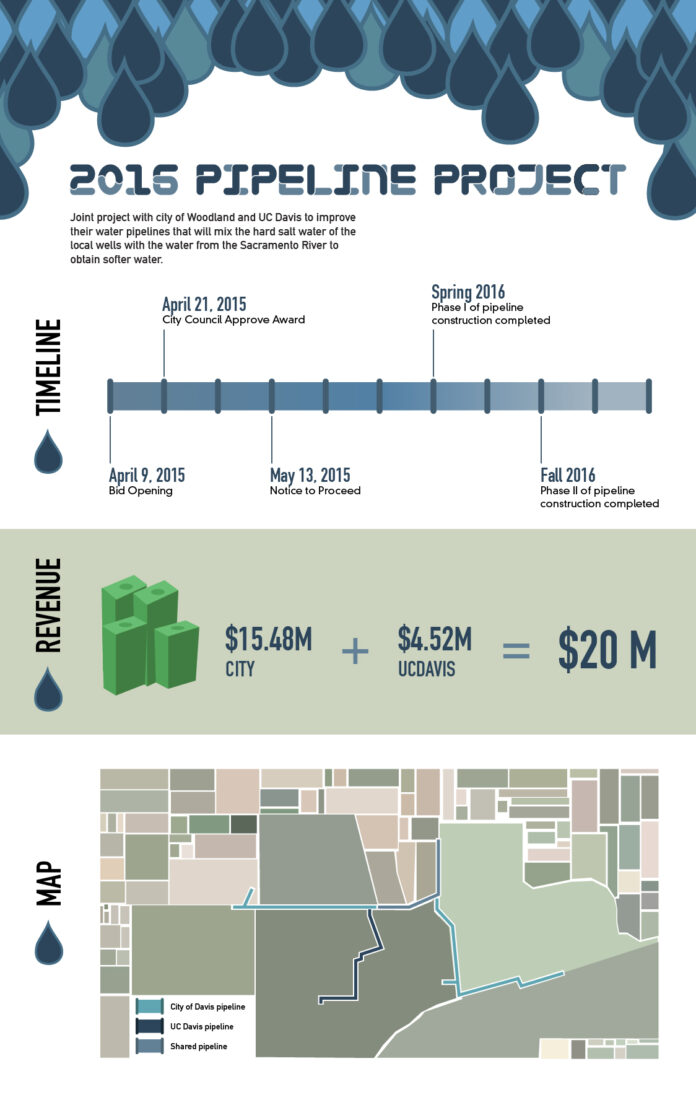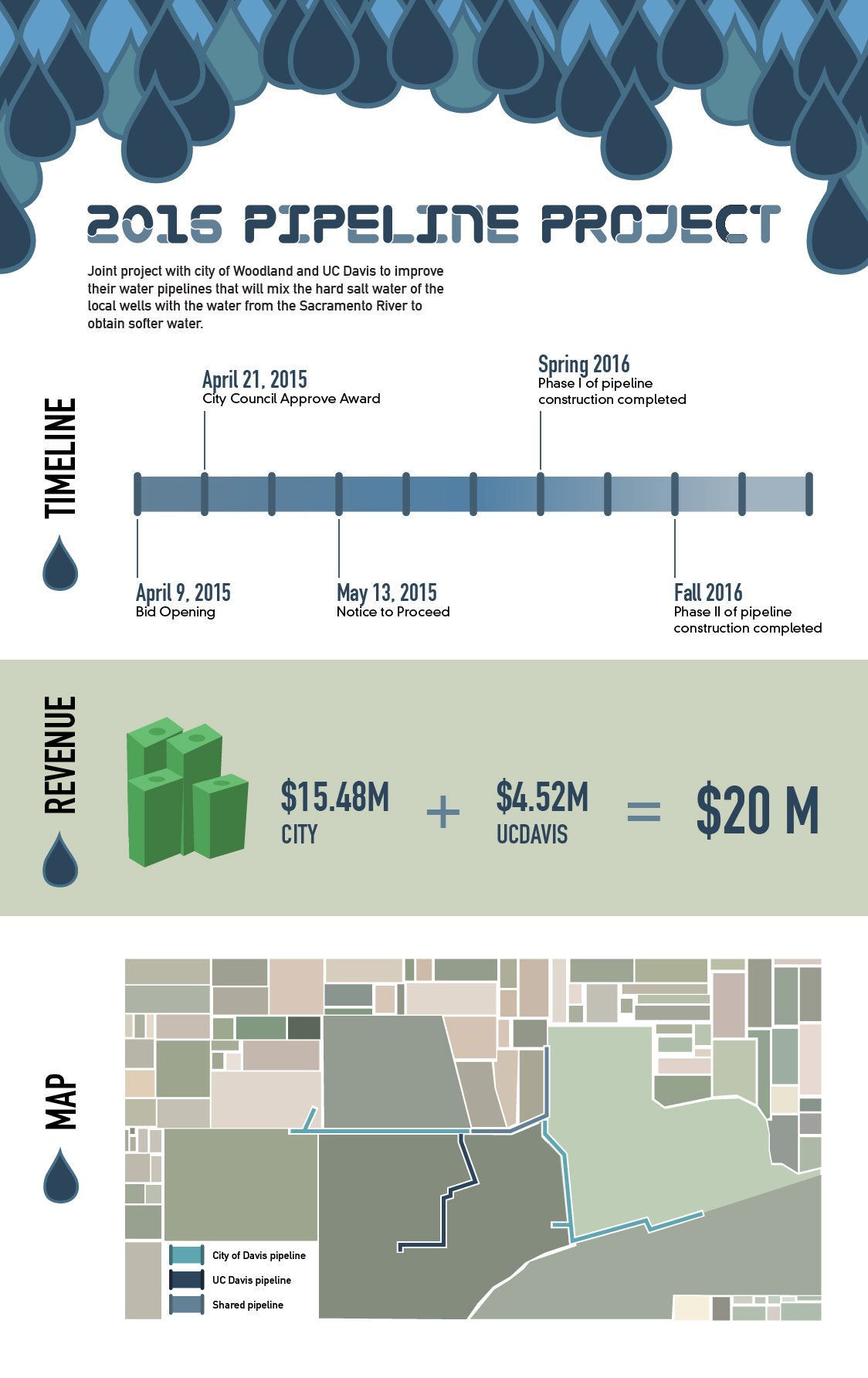Davis, Woodland, UC Davis to cooperate on the surface water pipeline project
On March 3, Davis City Council unanimously voted to follow the Public Works Director/City Engineer, Robert Clarke, and Project Manager, Diane Phillips’ recommendation of approving the Plans, Specifications and Estimate of the Water Quality Improvement Pipeline Project.
The approval would entail authorization of a bid advertisement, or the offering of bids to construction firms, with a bid opening to be conducted on April 9.
“The City of Davis, [the city of] Woodland and UC Davis are working on this. Initially, the plan was only Woodland and City of Davis get the water, and the university has the right to join the project in a future day,” said City Council member Brett Lee.
According to Lee, the project’s goal is to take the water from the Sacramento River and deliver it to Davis and Woodland. Currently, Woodland and Davis use well water. According to Stacey Winton, media and communications officer of the City of Davis, in addition to searching for more sustainable water source, there are problems found in regards to the water quality of well water.
“The water we get from the ground needs a lot of treatment… there are issues associated with the quality of water discharged. We would have to put a lot of money to upgrade our [current] treatment facilities to maintain the requirement the state has,” Winton said.
According to Lee, the well water used in Davis comes from two sources, deep wells and intermediate wells. The river water from the Sacramento River would be superior in quality than water extracted from intermediate wells.
“We were given the opportunity to take river water from the Sacramento River essentially for free. We have to build the water treatment plant to process and treat the water so that it would be up to drinking water quality,” Lee said.
In addition to that, according to Lee, Davis would not have access to the river water for free during the summer when the water flow is low, but instead the city would have to purchase summertime water rights. According to the Woodland-Davis Clean Water Agency website, the project will divert up to 45,000 acre-feet of water per year from the Sacramento River. The project will supply up to 30 million gallons of water per day, with an option for further expansion to up to 34 million gallons per day. Davis will receive 12 million gallons per day.
According to Stan Gryczko, Wastewater Treatment Plant Superintendent, the project will include building a transition main in the city that distributes the surface water received from the joint project “amongst the residence of the city as equally as possible.” According to the Woodland Davis Clean Water Agency website, the project’s primary goals include the provision of new water supply to meet existing and future needs, improvement of drinking water quality, and improvement to the quality of treated water.
The Water Distribution System Optimization Plan was completed in 2011 and updated in 2013. The approval of agreement with UC Davis for the construction and delivery of surface water in this joint project, agreed on Jan. 20, is one of the significant additions to the project.
Due to their participation, UC Davis will contribute approximately $1.179 million for the shared portion of pipeline. The university will also pay the full cost for the UC Davis pipeline, including the city administrative costs. According to Lee, the City Council is expecting UC Davis to officially join the project in the next month.
Camille Kirk, the assistant director of sustainability for the UC Davis Office of Environmental Stewardship and Sustainability could not comment at this time.
According to a recent council publication, the pipeline will be constructed in two phases. The first phase will be completed in the spring of 2016 from the north city limits to the existing city distribution system at 5th St.-Pole line rd. and Covell Blvd.-Anderson Rd. intersections. The completion of the UC Davis pipeline will also be included in the first phase. The second phase will be completed in the fall of 2016, and will comprise of tunneling the pipeline under Highway 113 and under Interstate 80. According to Lee, the City Council expects that the river water will be available for use by fall of 2016.
“Throughout the city, there are a number of different routes [of the pipeline]. [The main ones are] along Covell Boulevard, down the O-Line, [and] the UC Davis pipeline goes down M street and comes across A street,” Gryczko said.
According to Winton, residents have been notified of the upcoming road construction for the pipelines that transfer the water from the Water Treatment Plant south of Woodland to the City of Davis — an approximately eight-miles-long distance between the cities. According to Lee, the city has asked for property owners affected by the construction for the rights to build the pipeline, ensuring that the public is fully aware of this project.
In addition to that, according to the City Council’s staff report, there will be further public outreach involving the creation of an informative website that address solutions to the potential impacts of the pipeline construction. The website will include information on where construction is occurring and suggestions for detour routes among other things.
Graphic by Jennifer Wu.





